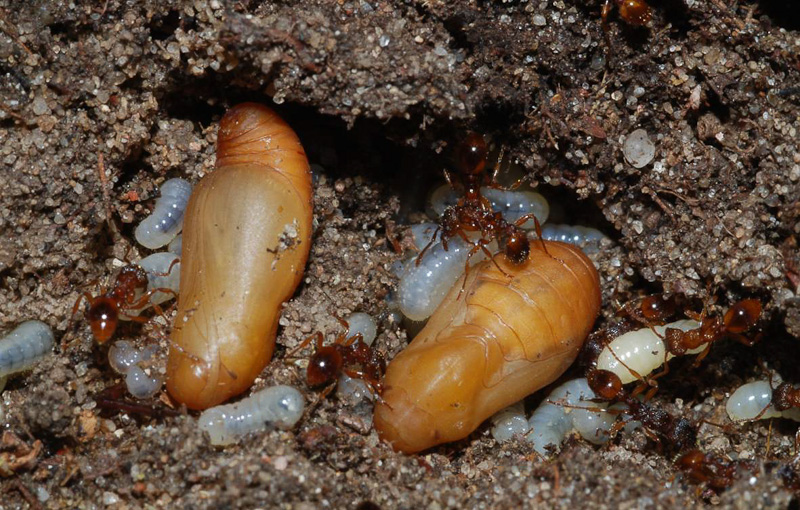Two colourful species come together but do not form purple unfortunately. These two animals are equally beautiful but butterflies are often more appreciated. When I say that butterflies and ants have interactions you may think it’s a pretty open and shut case. You may be thinking that if the butterflies are unfortunate enough to get in the way of the ants they’ll be eaten and that’s it. While that is true a lot of the time, this case is much more interesting. In this relationship the the red stinging ants are actually the victims here. All I’m saying is butterflies can be mean too and let’s find out how.
Life as a caterpillar is dangerous. There are predators, parasites and pesticides all trying to murder you. Oh my! That doesn’t sound too fun to me to be honest. So what do you do in a world that’s trying to kill you? Simple. You hire bodyguards. However, instead of paying these bodyguards you steal their food and eat their young before making a daring escape. Look I’m not going to lie the metaphor doesn’t really work very well but just stick with me.
I’m not exaggerating when I say the ants are some of the most feared animals in the animal kingdom. I mean spiders pretend to be them just so they don’t get attacked by predators. And if spiders find them scary that you can imagine how scary they are to a butterfly! Especially as ants are used to eating soft and squishy caterpillars.

The large blue butterfly, Phengaris arion, is a relatively small butterfly found throughout Eurasia. Whoever named it clearly had a problem with exaggeration. The species in general is classified as Near Threatened by the IUCN but is considered Critically Endangered in the UK and endangered in many areas in Europe. At one point it was extinct in the UK but conservation efforts brought them back. Myrmica sabuleti, a species of European fire ant, is the second member of this relationship. Their biology and behaviour is very similar to other members of its genus so it is often overlooked. Until now! Different species of butterfly and even individuals within the same species will also parasitize other ant species.
The story starts with a female butterfly laying her eggs on a specific group of plants, including thyme. They have been noted as avoiding laying on plants that already have lots of eggs on them. The caterpillars hatch and begin to feed like any others. Unlike others, these caterpillars fall to the ground and emit pheromones and sounds that are indistinguishable from those of the larvae of their host species. Yes ant larvae make sounds! If and when the ants find the caterpillars, they will think it is one of their own larvae and take them back to their nest as a member of the colony, not as food.
The workers will bring the caterpillar inside their nest and care for it like their own larvae. The feed it and clean it as much as they can as it grows and grows, eventually dwarfing the larvae there are pretending to be. Fortunately for them, ants use smell above all other stimuli to identify nestmates. In some species, including this one, the caterpillars even eat the young of their host colonies. To call this rude would be the understatement to end all understatements. They hibernate with the ants both protected and fed. Once they reach a good size, 100 times their starting weight, they spin their cocoons and pupate, growing in their most vulnerable state, surrounded by would be predators. They have guts, you cant deny! Even if they are liquified at this point!

When the time comes, the butterfly emerges from its cocoon. The ants now realise that they are, in fact, an intruder. The scales of the butterflies’ wings protect it as it escapes to the surface and flies away, ready to begin the cycle anew.
And there you have it. A great story from an unexpected source once again teaching us to never judge a book by its cover. I hope you enjoyed this post! If you did please share it around. The viewer number going up makes me happy. Thanks,
Alex.
References
DeVries, P.J., Cocroft, R.B. and Thomas, J., 1993. Comparison of acoustical signals in Maculinea butterfly caterpillars and their obligate host Myrmica ants. Biological Journal of the Linnean Society, 49(3), pp.229-238.
Thomas, J.A. and Elmes, G.W., 2001. Food–plant niche selection rather than the presence of ant nests explains oviposition patterns in the myrmecophilous butterfly genus Maculinea. Proceedings of the Royal Society of London. Series B: Biological Sciences, 268(1466), pp.471-477.
Thomas, J.A., Schönrogge, K., Bonelli, S., Barbero, F. and Balletto, E., 2010. Corruption of ant acoustical signals by mimetic social parasites: Maculinea butterflies achieve elevated status in host societies by mimicking the acoustics of queen ants. Communicative & Integrative Biology, 3(2), pp.169-171.
Thomas, J.A. and Wardlaw, J.C., 1990. The effect of queen ants on the survival of Maculinea arion larvae in Myrmica ant nests. Oecologia, 85(1), pp.87-91.
UK butterfly monitoring scheme https://ukbms.org/SpeciesFactsheets.aspx?speciesId=73
If you have enjoyed this site and its content please consider becoming a Patron so I can add more content in the future.
And check out what I do and where to find me here:
https://allmylinks.com/alexants

